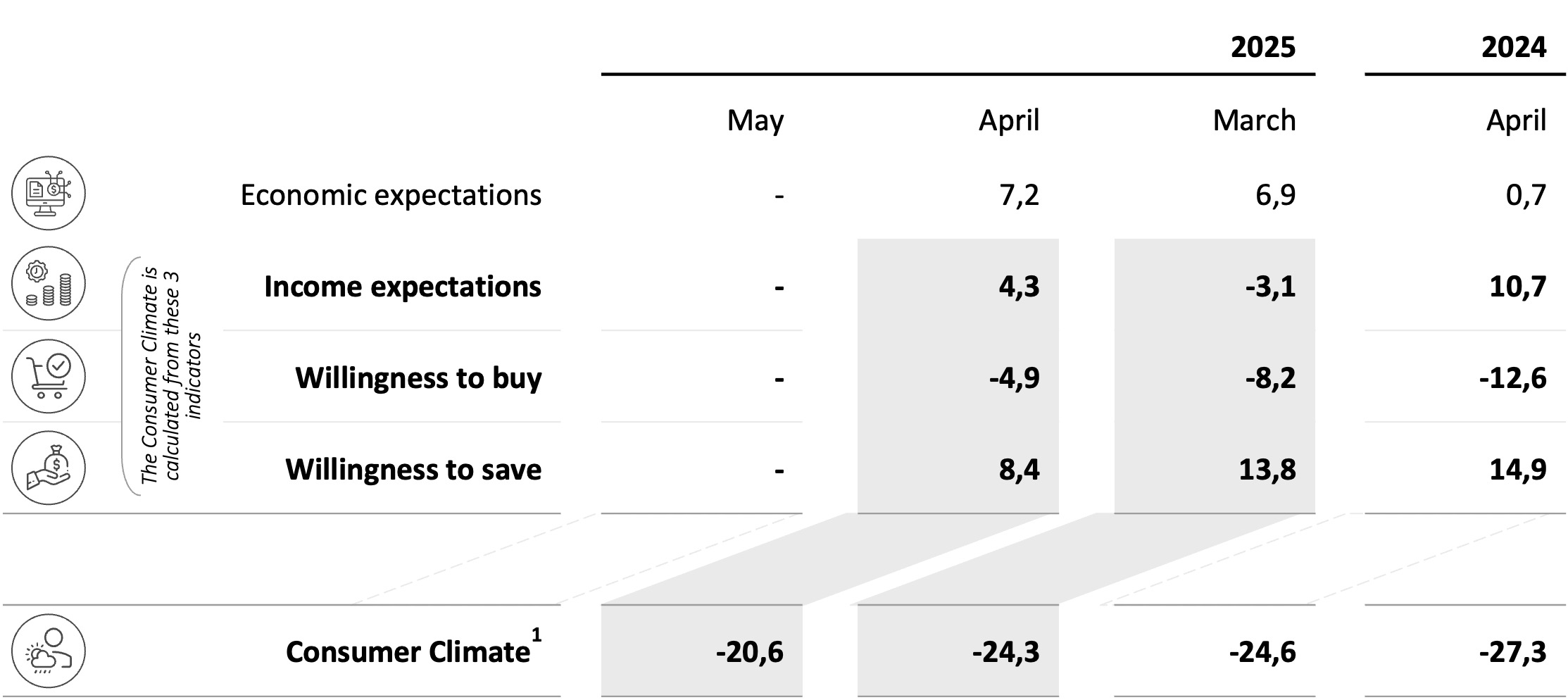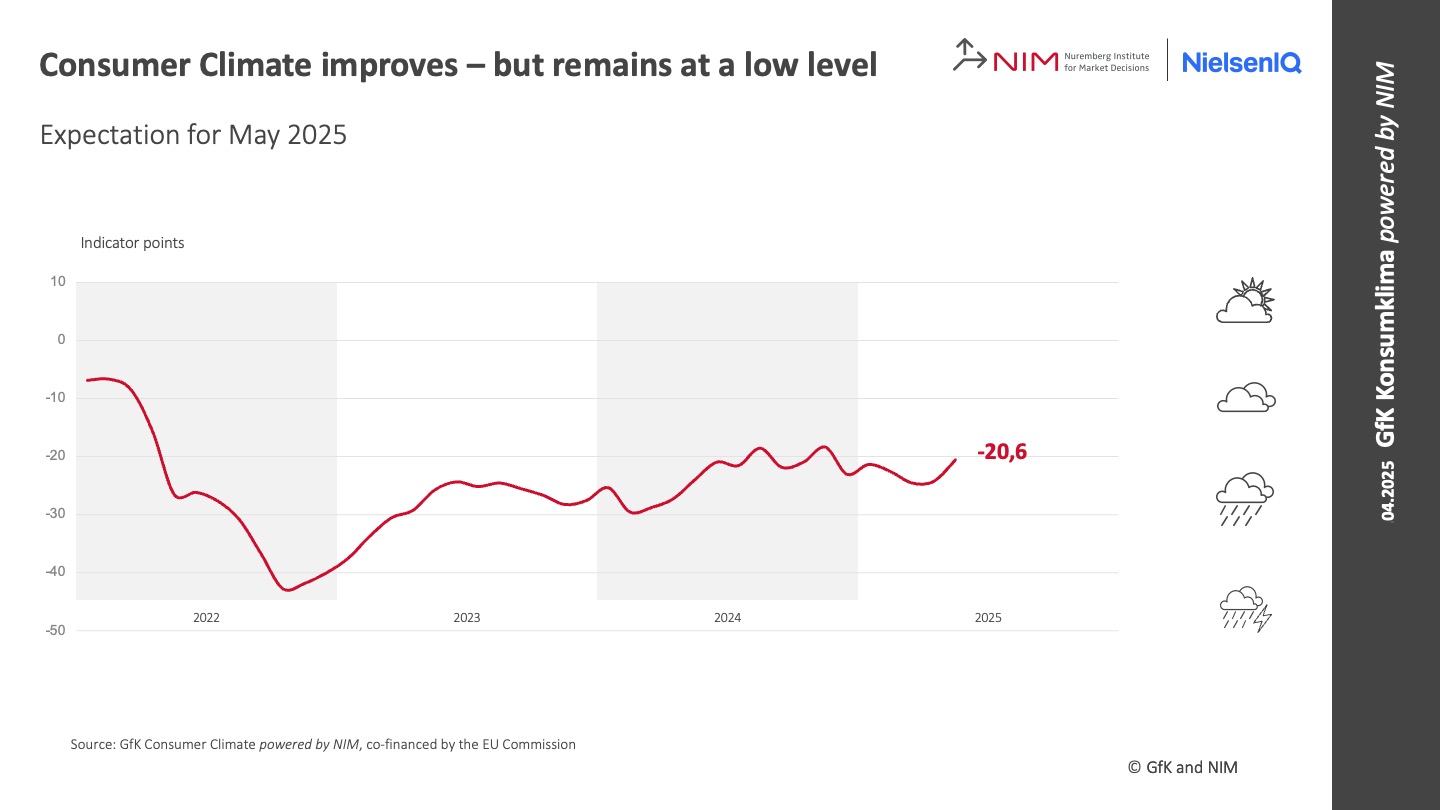Consumer Climate
2025
GfK Consumer Climate April 2025: Consumer Sentiment Improves – But Remains at a Low Level
Nuremberg, April 29, 2025 – Consumer sentiment in Germany continues its recovery in April that began in the previous month. Both income expectations and the willingness to buy show noticeable increases, while economic expectations improve only slightly. The willingness to save also declines significantly, thereby supporting the Consumer Climate: The indicator forecasts an increase of 3.7 points to -20.6 points for May 2025 compared with the previous month (revised -24.3 points). These are the findings of the GfK Consumer Climate powered by NIM for March, which has been published jointly by GfK and the Nuremberg Institute for Market Decisions (NIM), the founder of GfK, since October 2023.
In addition to rising income expectations and a growing willingness to buy, a noticeable decline in the willingness to save is currently strengthening the recovery in the Consumer Climate. After two consecutive increases, the savings indicator fell by 5.4 points in April to 8.4 points.
“The realignment of the US administration's trade policy, which began with the announcement of sharp tariff increases shortly before the start of the survey in early April, has apparently not yet had lasting impacts on consumer sentiment in Germany. Any negative effects are likely to be mitigated by the successful conclusion of coalition negotiations and the imminent formation of a fully functioning government,“ explains Rolf Bürkl, consumer expert at NIM. “It is clearly more important to German consumers at present that a government will be formed quickly. As a result, a key driver of previous uncertainty has lost significance – and the willingness to save has declined accordingly. We know from our in-depth analyses that uncertainty is a major reason for the high willingness to save. Whether the decline in savings will continue over the coming months remains to be seen and will certainly also depend on how the trade conflict between the U.S. and the rest of the world develops."
Income expectations rise noticeably
Income expectations rise for the second month in a row. Following moderate gains in the previous month, the income indicator rises noticeably by 7.4 points in April. It thus climbs to 4.3 points, its highest level since October 2024, when it stood at 13.7 points. However, there is still a decrease of 6.4 points compared with April 2024.
The overall more positive income outlook is likely also due to the collective bargaining agreement reached for the public sector in early April. According to the agreement, employees of the federal government and municipalities will receive a salary increase of three percent as of April 1, 2025, with a minimum increase of 110 euros per month. An additional increase of 2.8 percent will follow on May 1, 2026. This exceeds the currently expected inflation rate of just over two percent, which should benefit purchasing power.
The willingness to buy also increases for the second time in a row
The willingness to buy also benefits from the significantly improved income expectations this month. It gained 3.3 points and currently stands at -4.9 points. Compared to the same period last year, this represents an increase of 7.7 points.
Overall, the willingness to buy remains at a low level. However, an upward trend has been observed since the beginning of 2023 (January 2023 value: -18.7). Whether this can continue depends on whether inflation remains at around 2 percent, close to the European Central Bank's (ECB) target. However, a renewed increase in uncertainty, such as from an escalating trade conflict, would likely destroy any further recovery in consumer sentiment.
Economic expectations increase slightly
This month, economic expectations rise for the third time in a row, but the increase is modest at 0.3 points. The indicator thus stands at 7.2 points in April 2025. A better value was last measured in July 2024 with 9.8 points. Compared with the same period last year, the increase is 6.5 points.
Thus, despite the uncertain developments in the stock markets caused by the U.S. administration’s trade policies, German consumers' economic expectations remain resilient. At the same time, growth forecasts for this year have been revised downwards once again. The country now faces its third consecutive year of recession – a novelty in the post-war history of the Federal Republic.
The following table shows the values of the individual indicators in April 2025 compared to the previous month and previous year:
1Consumer Climate can be interpreted as a leading indicator of consumer behavior in Germany. Analyses have shown that sentiment is an early indicator for the actual development of private consumption. The Consumer Climate is calculated from the April values for income expectations, willingness to buy and willingness to save - as a leading indicator for the development of consumption in May 2025.
The following diagram shows the development of the Consumer Climate indicator over the last few years:
Planned publication dates in 2025 (CET):
- Tuesday, May 27, 2025, 8 a.m.
- Thursday, June 26, 2025, 8 a.m.
- Thursday, July 24, 2025, 8 a.m.
- Wednesday, August 27, 2025, 8 a.m.
- Thursday, September 25, 2025, 8 a.m.
- Tuesday, October 28, 2025, 8 a.m.
- Thursday, November 27, 2025, 8 a.m.
- Friday, December 19, 2025, 8 a.m.
About the method
The survey period for the current analysis was from was from April 3 to April 14, 2025. The results are extracted from the “GfK Consumer Climate powered by NIM” study and are based on around 2,000 consumer interviews per month conducted on behalf of the European Commission. The report presents the indicators in the form of graphics accompanied by brief comments. Consumer sentiment refers explicitly to all private consumer spending. Depending on the definition used, however, retail accounts for only around 30 percent of private consumer spending. Services, travel, housing costs, healthcare services, and the wellness sector as a whole account for the rest. Again, this does not apply to retail sales, but instead to total consumer spending. Like all other indicators, willingness to buy is a confidence indicator. It indicates whether consumers currently consider it advisable to make larger purchases. Even if they answer “Yes” to this question, there are two further requirements for making a purchase: The consumer must have both money required for such a large purchase and must also see a need to make this purchase. Furthermore, this only concerns durable consumer goods that also require a larger budget.
GfK Consumer Climate powered by NIM
The GfK Consumer Climate survey, which is being conducted regularly since 1974 and monthly since 1980, is regarded as an important indicator of German consumer behavior and a guiding light for Germany’s economic development. Since October 2023, the Consumer Climate data collected by GfK has been analyzed and published jointly with the Nuremberg Institute for Market Decisions (NIM), the founder of GfK. By joining forces, it will be possible to invest further in the analysis and development of the Consumer Climate study to gain an even better understanding of the background to changes in consumer confidence.
Media Contact:
NIQ: Corina Kirchner, T +49 911 395 4570, corina.kirchner@nielseniq.com
NIM: Sandra Lades, T +49 911 95151 989, sandra.lades@nim.org
GfK – a NielsenIQ company
For 90 years, clients around the world have trusted us to provide data-driven answers to key questions for their decision-making processes. We support their growth through our comprehensive understanding of buying behavior and the dynamics that influence markets, brands, and media trends. In 2023, industry leaders GfK and NielsenIQ have merged to offer their clients unparalleled global reach. With a holistic view of retail and the most comprehensive consumer insights, provided by forward-looking analytics on state-of-the-art platforms, GfK is driving “Growth from Knowledge.” More information is available at www.nielseniq.com.
About NIQ
NielsenIQ (NIQ) is a leading consumer intelligence company, delivering the most complete understanding of consumer buying behavior and revealing new pathways to growth. NIQ combined with GfK in 2023, bringing together two industry leaders with unparalleled global reach. Our global reach spans over 90 countries covering approximately 85% of the world’s population and more than $ 7.2 trillion in global consumer spend. With a holistic retail read and the most comprehensive consumer insights—delivered with advanced analytics through state-of-the-art platforms—NIQ delivers the Full View™.
For more information, please visit www.niq.com
Nuremberg Institute for Market Decisions e. V.
The Nuremberg Institute for Market Decisions (NIM) is a non-profit research institute at the interface between science and practice. The NIM investigates how consumer decisions change as a result of new technologies, social trends or the application of behavioral science and what micro- and macroeconomic effects this has on the market and society. A better understanding of consumer decisions and their effects helps society, companies, politicians and consumers to make better decisions in the interests of a socio-ecological market economy and "prosperity for all".
The Nuremberg Institute for Market Decisions is the founder of GfK.
Further information at www.nim.org/en and LinkedIn.



![[Translate to English:] [Translate to English:]](/fileadmin/PUBLIC/1_NIM_NIM/Team/R.Buerkl_NIM.png)